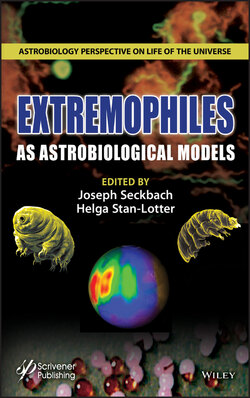Читать книгу EXTREMOPHILES as Astrobiological Models - Группа авторов - Страница 38
2.5 Tinto Basin Sedimentary Geomicrobiology
ОглавлениеAs previously mentioned, most of the biomass from the Tinto ecosystem forms colorful biofilms on the riverbed and on its rock surfaces. Iron minerals precipitate on the surface of these biofilms according to the hydrological cycles, consolidating into distinct fluvial terraces [2.35] [2.37].
During the dry season the evaporation of river water drives precipitation of schwertmannite and hydronium jarosite, whereas gypsum, coquimbite, copiapite and other sulfate minerals are transported to the surface by capillary action, generating effluorescences [2.37]. During the rainy season, hydrolysis of sulfates in addition to the iron hydrolysis results in the precipitation of amorphous iron oxyhydroxides and nanophase goethite. In the oldest river terraces, increasing goethite crystallinity and its replacement by hematite can be observed (Figure 2.2).
Biosignatures, such as textures of coated microbial streamers, surface blisters generated by biogenic gas and microfossils preserved in iron oxides, can be detected in the sedimentary rocks, which could be of help in designing strategies for future astrobiological exploration missions [2.37] [2.39] [2.8]. Until recently, the extreme conditions of pH and high concentration of toxic heavy metals identified in the Tinto basin were considered the consequence of over 5000 years of mining activities [2.51] [2.68] [2.27]. However, recent geological, geophysical and hydrogeological information does not support this assumption. The recharge area of Peña de Hierro aquifer was detected northwest of the pit lake at a depth ranging from 100 to 400 mbs [2.56]. Its groundwater moves southwards along the fracture network and when it reaches the massive sulfide bodies it activates the metabolism of chemolithotrophic microorganisms, generating acidic waters with high concentrations of iron and sulfate [2.38] [2.56]. This acidic groundwater is pumped along open strike-slip normal faults and eventually reaches the surface, where it sources the acidic springs that feed the Rio Tinto headwaters. Thus, the acidic waters with high content of iron and sulfate are the consequence of the subsurface oxidation of metal sulfides, mainly pyrite, by chemolithotrophic microorganisms operating in strict anaerobic conditions. Consequently, mining activities that brought sulfidic minerals to the surface are not the main cause of the distinctive acidity and high concentration of heavy metals detected in the river. This hypothesis is strongly supported by the sedimentary record of the ancient terraces deposited along the Tinto basin [2.37]. The oldest, containing finely laminated and massive ironstones, has been dated 2.1 (million years ago) Ma. This means that several millions of years before the oldest recorded mining activity, the natural bioleaching of native unexposed sulfidic minerals (subterranean and, as a consequence, in anoxic conditions) gave rise to the ionic conditions that generated the old terraces [2.38]. Furthermore, the oldest gossan deposits in the Tinto basin, representing the remaining materials of the in-situ bioleaching of the sulfidic deposits, were dated older than 7 Ma [2.32], underscoring the natural origin of the river.
Recently, the remarkable biomineralization of hydronium jarosite in non-permissive ionic conditions by Purpureocillium lilacinum, a filamentous fungi isolated from Rio Tinto [2.82], has been described. In addition, siderite was identified in the modern sediments of the river [2.42], which was also produced in cultures of the acidophilic iron reducer Acidiphilium sp., one of the major microorganisms identified in the Tinto basin [2.97]. These results clearly show that the presence of microorganisms can generate nucleation sites which could radically modify the expected mineral precipitation schemes predicted by the global physicochemical conditions of the environment in which they develop [2.82] [2.83] [2.84]. Furthermore, the detection of organic molecules in the oldest Rio Tinto terraces indicates that even in the extreme acidic and oxidant conditions of the system this ferruginous environment can preserve the molecular information of organisms that have inhabited this extreme environment for long periods of time [2.22] [2.89].
Figure 2.2 Comparison between ferruginous deposits of the Burns Formation (a) cropping up in the Endurance Crater and those formed by acidic fluvial activity (b) in Rio Tinto. In the fluvial deposits of Rio Tinto, jarosite and hematite were detected using different techniques such as X-ray diffraction (c), which form as a consequence of the low pH. The same mineral association has been found on Mars. (Image credits: image A, PIA07110, NASA/JPL/Cornell; images B & C, the authors).
Considering the geomicrobiological characteristics of the Tinto ecosystem we propose that Rio Tinto is mainly under the control of iron [2.7]. Iron oxidizing microorganisms are responsible for the solubilization of the massive metal sulfides of the IPB and the associated high concentrations of iron and sulfate measured in the river. Iron has diverse properties of biological interest, which make the Rio Tinto basin an attractive astrobiological precedent [2.11]. Reduced iron is a good electron donor for respiration (both aerobic and anaerobic). Oxidized iron is a useful electron acceptor for anaerobic respiration. Oxidized iron is also a good buffer for controlling the pH of the system. Moreover, it has been shown that soluble ferric iron can protect sensitive organisms from damaging UV radiation [2.54] [2.55].
This iron-controlled environment appears to be adequate for the chemolithotrophic microorganisms detected in the Tinto basin. Nonetheless, taking into consideration that eukaryotic diversity seems to be much greater than prokaryotic [2.72] [2.5] [2.3], and that most of the primary production in the system depends on eukaryotic photosynthesis, how do eukaryotes benefit from adapting to an extreme acidic environment with high concentration of toxic heavy metals? One possible answer to this question might be related to free access to an indispensable element for life, iron. Iron is difficult to obtain at neutral pH, due to its meager solubility in this condition [2.14] [2.77] [2.19] [2.18]. A reliable advantage for the eukaryotes growing in the Tinto basin is an unrestricted iron supply provided by the chemolithotrophy promoted by the extremely high concentration of IPB iron sulfides [2.53] [2.7] [2.11].
